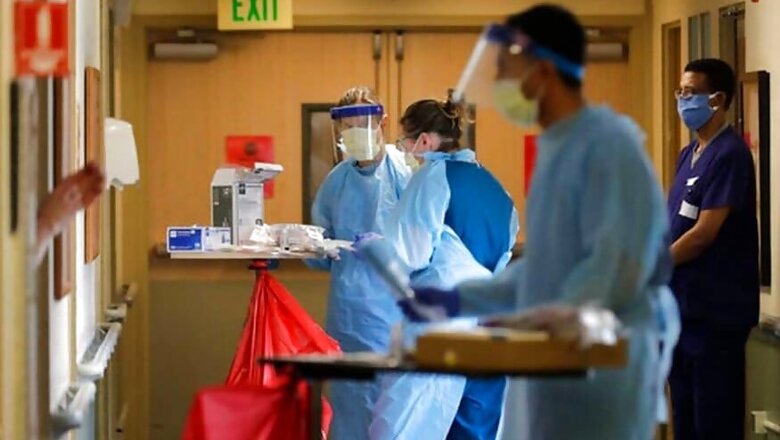
views
At a time when our overworked government-run medical facilities are battling the Covid-19 pandemic on the front lines, it is imperative to revisit and review our public healthcare fundamentals. Primary healthcare is the fulcrum around which our entire healthcare delivery system is organised. It is also one of the most fundamental steps toward the chimera, that is universal healthcare.
On the infrastructure front, primary healthcare in India lies chiefly in the domain of sub-centres (SCs) and primary health centres (PHCs). As of March 2018, there were 1.39 health centres (either of SCs and PHCs) per 10,000 people nationally with a shortage of 32,900 SCs & 6,430 PHCs.
Besides the existing 46 per cent shortfall of doctors in PHCs, 74 per cent of the current graduate doctors reside in urban India leaving a large chunk of the rural population underserved. The vacancy rate of doctors is 24.9 per cent across rural PHCs.
Over 10 lakh Accredited Social Health Activist (ASHA) workers are the first point of contact between the community and the public health system, even in remote parts of our country. They are demotivated as they are treated in a subpar manner by the government and other health personnel.
Unflattering numbers
India ranks 145th among 195 countries according to a Lancet study on quality and accessibility of healthcare (2016). India’s per capita government health expenditure in 2017 was USD 18.8 per individual (roughly Rs 1,420), which is substantially lower than what BRICS nations or populous countries like China (USD 249.8) spend. A study by PricewaterhouseCoopers (PwC) estimates that India would require an additional 30 lakh doctors and 60 lakh nurses by 2035, which would cost us 16.22 lakh crore rupees or about 7.48 per cent of the Gross Domestic Product (GDP) in 2018.
A study by PRS Legislative Research has revealed that the entire healthcare expenditure (both central and all state governments put together) in India as a percentage of GDP has only been around 1.2 to 1.6 between 2008-09 and 2019-20. Though health is a state subject, the budget allocation of the union ministry of health and family welfare hovers around a paltry 0.3 per cent of GDP in the past decade. Most of the Non-Empowered Action Group (Non-EAG) states spend 0.76 per cent of their GSDP (Gross State Domestic Product) for health expenditure while EAG states spend 1.36 per cent of GSDP.
The National Health Policy [2017] suggests that the central government must spend 2.5 per cent of GDP by 2025 and state health spending must rise above 8 per cent of their budgets by 2020. The government of India’s High-Level Expert Group on Universal Healthcare [2019] has recommended allocating 70 per cent of the healthcare budget for PHCs.
The way forward
Public health should indeed be deemed non-excludable and non-rivalrous and hence a public good similar to national defence as defined by the economist Paul Samuelson. The Supreme Court has interpreted in many instances on Right to Health being an integral part of Right to Life under Article 21. A constitutional amendment to explicitly ensure that Right to Primary Healthcare is a fundamental right of every Indian citizen is an idea whose time has come. Instead of just being meretricious tokenism, it will in fact be a constitutional covenant of commitment by the Indian State to our people.
While the government has announced a slew of privatisation measures in the backdrop of the coronavirus crisis, public investment is the immediate need of the hour to transform our healthcare system. On the lines of the Fiscal Responsibility and Budget Management Act, we would do well to commit an increased percentage of our GDP for healthcare by an Act of Parliament and also mandate all states to pass consonant laws.
One cannot turn a Nelson’s eye towards the dichotomy of the current rural vacancy of doctors when making a case for expanding primary health infrastructure and human resources. While a 2019 Supreme Court ruling upheld mandatory rural service after education as implemented by 12 states like Rajasthan and West Bengal, it also urged the Centre and Medical Council of India to frame a uniform national policy regarding the same.
Sri Lanka offers interesting insights on other factors impacting the success of rural postings. On completing their internship, doctors can choose their place of posting and the government decides on a point-based merit system. A well-maintained system of rotation and voluntary transfer also exists. Allowing private practice has also ensured better rural retention rate. A similar policy calibrated according to the Indian context would be a step in the right direction.
ASHA workers can be recognised with government employee status and provided with other benefits like insurance, pension, etc. In 2011-2012 out of the 5.5 crore people impoverished due to health costs, out-of-pocket expenditure on medicines pushed about 3.8 crore of them back into poverty. In response, the model of centralised pooled procurement of medicines introduced in states like Tamil Nadu and Kerala could be examples to emulate to ensure affordability and availability of medicines.
The experiences of multiple countries in the wake of the Covid-19 pandemic have made an emphatic case for an increased public investment in health expenditure. That primary healthcare needs to be a near exclusive domain of the State, both at the central and regional level, is a sine qua non.
CR Kesavan is a former member of the Prasar Bharati Board. @crkesavan
Vignesh Karthik KR is a doctoral researcher at King’s College, London. @krvtweets
Views expressed are personal.

















Comments
0 comment